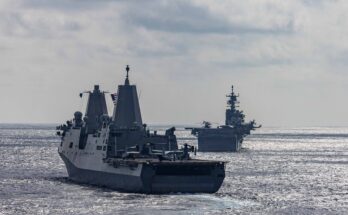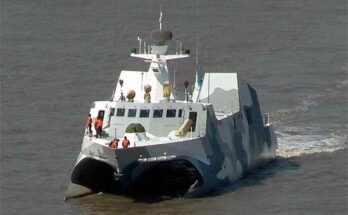by Dan Darling, International Military Markets Analyst, Forecast International.
In a highly anticipated decision, Australia’s center-right government opted for a French design to meet its Sea 1000 Future Submarine requirement. The project involves the construction of 12 submarines that will serve as a successor class to the Royal Australian Navy’s current Collins class fleet. French shipbuilder DCNS offered up a diesel-electric variant – the Shortfin Barracuda Block 1A – of its nuclear-powered Barracuda attack submarine built for the French Navy.
The AUD50 billion ($38 billion) Sea 1000 Future Submarine project is not just the country’s most expensive defense program, but is considered one of the most crucial for Australian defense in terms of both long-term security and economic impact. The outlines of the project had been batted about for years as previous governments (including three iterations of a Labor-led government headed by two different prime ministers and two iterations of Liberal-National Coalition governments headed by two prime ministers) struggled to determine an optimal solution.
It was not until the Coalition government of Prime Minister Malcolm Turnbull unveiled Australia’s long-awaited Defense White Paper in February 2016 that a final determination of a 12-submarine purchase maximizing Australian industrial involvement was reached. Australian officials were very keen on the latter aspect – for both national industry and political reasons.
The contest pitted France’s DCNS against bids from Japan’s Mitsubishi Heavy Industries and Germany’s ThyssenKrupp Marine Systems (TKMS). The German bid involved Germany’s existing Type 216 platform, while Japan sought a government-to-government arrangement that included an evolved variant of the nation’s Soryu class.
The Japanese bid had gained momentum in 2014 under the previous Liberal-National Coalition government headed by former Prime Minister Tony Abbott.
Japan’s prime minister, Shinzo Abe, and Abbott had formed a bond that involved deepening regional security ties and fostering joint defense technology research between the two countries. Impressed by the ultra-quiet air-independent propulsion system in Japan’s 4,200-ton Soryu conventional submarines that allow each boat to remain submerged for up to two weeks at a clip, Abbott and former Defense Minister David Johnston appeared greatly in favor of the Japanese solution. In return, Shinzo Abe spent great political capital pushing Japan’s parliament to alter interpretations of the country’s pacifist constitution in order to allow for the export of military hardware.
But the preference for a Japanese-sourced option shown by Abbott and Johnston earned pushback from political, industrial and defense research quarters alike. By early September 2014, reports that the Abbott government had decided upon a purchase of 8-12 submarines from Japan stoked considerable controversy on the home front.
When Tony Abbott opaquely announced on September 8, 2014, that his government would seek to find the best solution at the optimal cost to the taxpayer, the leading opposition Labor Party pounced. Seeking to galvanize one of its constituencies, local unions, it argued that purchasing Japanese subs instead of locally made ones would compromise national security and hurt Australia’s shipbuilding industry.
Ultimately, Abbott’s inclination toward a Japanese solution to Sea 1000 sparked pushback within his coalition, largely from MPs in South Australia fearful that an export order depriving Australian shipbuilders of crucial submarine work would result in lost seats come election time. By February 2015, Abbott and his new defense minister, Kevin Andrews, had declared that the Future Submarine project would undergo a formal competition, with any contract including a series of capability requirements and Australian content commitments.
In the end, Australia opted for France’s bid on technical, rather than political, grounds. The DCNS bid, it was believed, would best meet Australia’s requirements for submarines with considerable range, superior sensor performance, and stealth characteristics, as well as providing an industrial partner for Australia’s ASC (Australian Submarine Corporation) with a track record in executing transfer-of-technology arrangements in submarine development projects with international partners.
Under the competitive bid put forth, all 12 submarines will be built at ASC’s Osborne shipyards in Adelaide. Each submarine will be equipped with the Mk 48 Mod 7 Common Broadband Advanced Sonar System (CBASS) torpedo jointly developed by Australia and the United States, as well as an American-designed combat system – the General Dynamics BYG-1 that already equips the Collins class boats. The latter aspect appeared to be a sticking point for the French bid in the run-up to a final Australian decision, as reports indicated that American officials had pushed Canberra on accepting the Japanese proposal, warning that it might not allow the combat system to be installed on European submarines.
But between apparent assurances from the White House to Prime Minister Turnbull that no such restrictions would be placed on a sovereign Australian decision and the feeling in Canberra that Japanese bureaucrats and defense companies were not enthusiastic about their government’s submarine bid – which could potentially derail the project in the long run – a unanimous opinion in favor of the French proposal formed amongst Australian defense officials.
With a winning bid reached, the Sea 1000 Future Submarine project now moves on to the design phase. Australia hopes to begin delivery of the new submarines in the mid-2020s to coincide with the phased retirement of the Collins class. More importantly, Australia hopes to avoid the problems that plagued the trouble-prone Collins class, which will not meet their availability benchmark until later in 2016, or roughly 20 years since first entering service.
Please feel free to use this content with Forecast International and analyst attributions, along with a link to the article. Contact Ray Peterson at +1 (203) 426-0800 or via email at ray.peterson@forecast1.com for additional analysis.
The Forecast International International Military Markets series examines the military capabilities, equipment requirements, and force structures inventories of 140 countries, with corresponding coverage of the political and economic trends shaping the defense market outlook for individual countries and regions.
For 50 years, Forecast International intelligence reports have been the aerospace and defense industry standard for accurate research, analysis, and projections. Our experienced analysts compile, evaluate, and present accurate data for decision makers. FI's market research reports offer concise analysis of individual programs and identify market opportunities. Each report includes a program overview, detailed statistics, recent developments and a competitive analysis, culminating in production forecasts spanning 10 or 15 years. Let our market intelligence reports be a key part of reducing uncertainties and mastering your specific market and its growth potential. Find out more at www.forecastinternational.com




